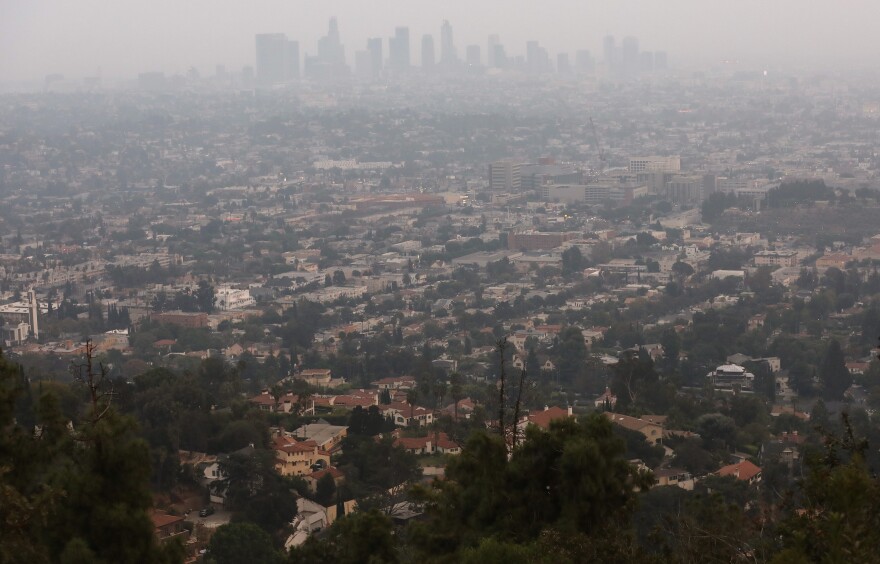Truth matters. Community matters. Your support makes both possible. LAist is one of the few places where news remains independent and free from political and corporate influence. Stand up for truth and for LAist. Make your year-end tax-deductible gift now.
California Approved A Very Bold Plan To Cut Planet-Heating Pollution

It’s been a big week on the climate front. The same day state utility regulators cut rooftop solar incentives, state air regulators approved a very ambitious roadmap to cut planet-heating emissions. The overall goals include slashing greenhouse gas emissions in half this decade and getting to net-zero carbon emissions no later than 2045.
Net zero, also called carbon neutrality, is reaching the point where we're not emitting more carbon than we absorb (like we do now). That absorption, or sequestration, can happen naturally through preserving or restoring landscapes such as wetlands and forests, or unnaturally, such as through engineered carbon capture systems.
Climate justice policy advocate Kyle Heiskala with nonprofit Environmental Health Coalition said the plan approved Thursday includes some big grassroots wins, such as goals to dramatically reduce car travel and urge more investment in public transit that many people with lower incomes rely on.
“What we have seen with this updated scoping plan is that, really for the first time, some meaningful shifts toward centering environmental justice,” Heiskala said. “The challenge ahead of us is creating that inter-agency collaboration that pulls in the lived experience of community members who ride transit every day.”
The Roadmap
The state estimates it’ll need to at least double the amount of electricity it generates to support more electric vehicles, electric appliances and other efforts to get off fossil fuels. To do that, the state will need to quadruple its solar and wind power, which means — in just the next 13 years — efforts to build large-scale solar and battery storage will need to speed up by a whopping 700%.
Pollution spewed by cars and trucks accounts for more than 40% of the state’s total emissions, so it’s necessary to not only get more people into electric vehicles, but also get us to drive a lot less. The plan projects that Californians will be driving 25% fewer miles by 2030 — but that’s a big “if.”
L.A. alone has a history of leaving public transit promises unfulfilled and is far behind on its own mobility plan, while L.A. Metro has plans to expand freeways yet again and negate any emissions reductions from improving public transit.

Implementing the plan as a whole will be a major challenge. Heiskala said that while environmental justice community members and advocates were much better involved in developing the plan, the goals are still quite broad and have some big assumptions, with little specifics on how to actually achieve them.
“While there was that shift in working more closely with environmental justice,” he said, “there still is a potential to continue the legacy of environmental racism and harm to front line communities living in the most polluted areas of California.”
That’s in part because the plan relies heavily on controversial technologies such as hydrogen, biogas, and engineered carbon capture, which is basically capturing the carbon from smokestacks of power plants before it gets into the atmosphere to further heat up the planet. Opponents worry it’s just another way to extend the life of the fossil fuel industry.
Carbon capture also doesn’t eliminate dangerous air pollutants like benzene, said Olivia Seideman, climate policy coordinator with non-profit Leadership Council for Justice and Accountability in Fresno. There are plans to store much of the carbon captured at power plants in the L.A. area underground in the Central Valley.
“We're seeing a huge over-reliance on these technologies,” Seideman said. “That is a really huge concern for communities across California that are experiencing disproportionate air pollution burdens. We really should be prioritizing direct emissions reductions and natural carbon sequestration where possible.”
The plan does also incorporate how changing agriculture and conserving land are critical to sequestering carbon and lowering emissions.

In the plan, the state estimates it’ll need to at least double the amount of electricity it generates to support more electric vehicles, electric appliances and other efforts to get off fossil fuels. To do that, the state will need to quadruple its solar and wind power, which means — in just the next 13 years — efforts to build large-scale solar and battery storage will need to speed up by a whopping 700%.








